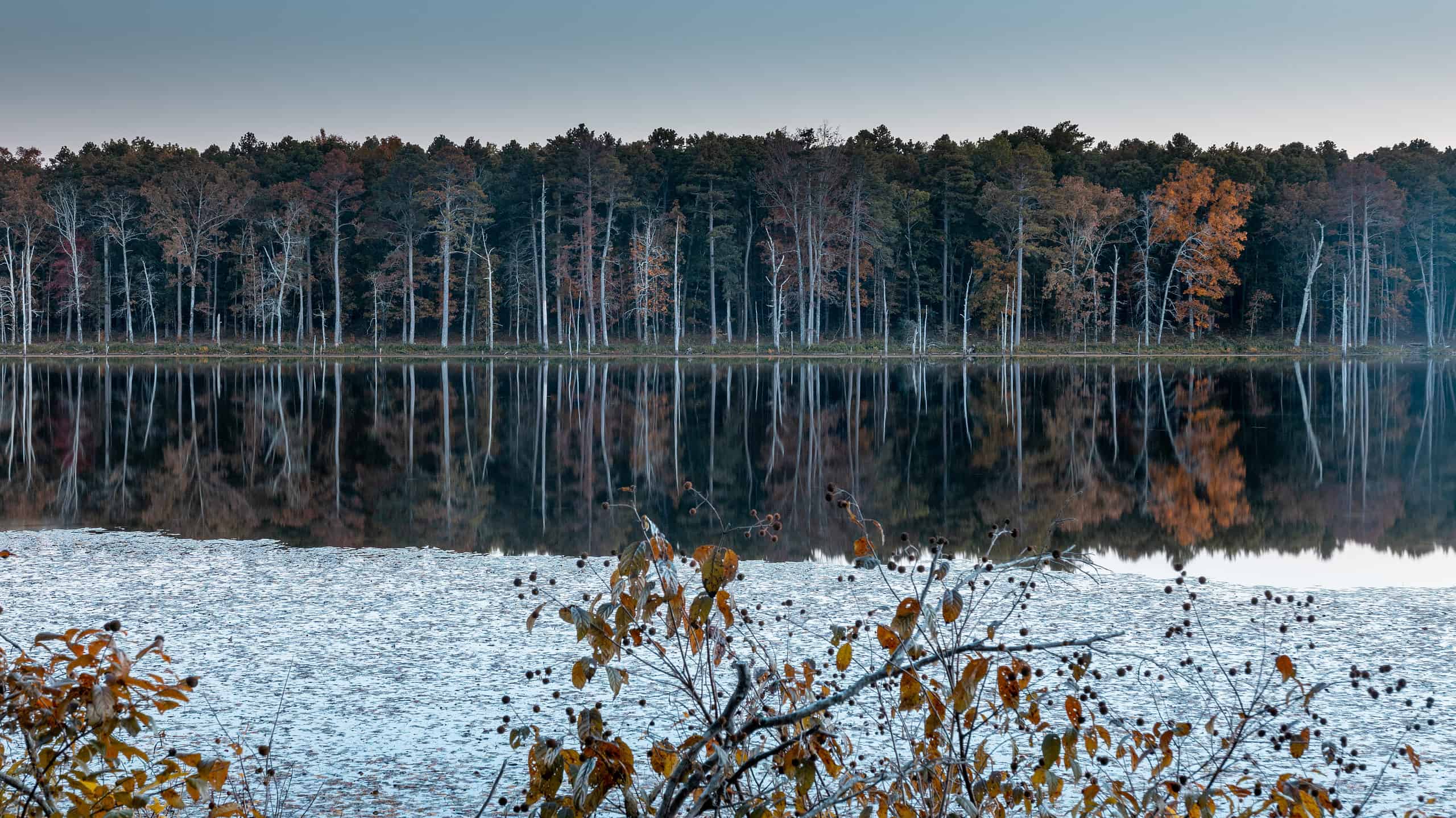The state of Missouri contains a number of natural wonders and beautiful outdoor locations to explore. About 33,000 square miles of the Ozarks and 4,400 springs lie within the state.
According to the Missouri Department of National Resources, many of these springs are the result of carbonate bedrock such as limestone and dolomite, dissolving away.
Some natural springs are even formed from water entering a sinkhole and traveling many miles underground before reemerging as a spring. Out of the thousands of natural springs in Missouri, these are the top eight that you don’t want to miss.
1. Alley Spring and Mill
Alley Mill overlooks a beautiful turquoise spring in Eminence, MO. George Washington McCaskill constructed the mill in the late 19th century, writes the National Park Service. The mill remains to this day and visitors can take a tour of the historic red building during the summer months.
The surrounding area is an ideal location for camping, hiking, paddling, swimming, and fishing. However, swimming in Alley Spring itself is strictly prohibited. Alley Spring is the seventh largest spring in Missouri, known to extend over 3,000 feet underground, with depths of at least 155 feet below the surface, according to See the Ozarks.
Alley Spring and Mill is located in Shannon County in southern Missouri. You can reach the Alley Spring natural area via Highway 106. Two trails lead to the natural area — the 0.75-mile Spring Branch Trail or the 1.5-mile Overlook Trail. Access the trails near the historic Alley Mill.
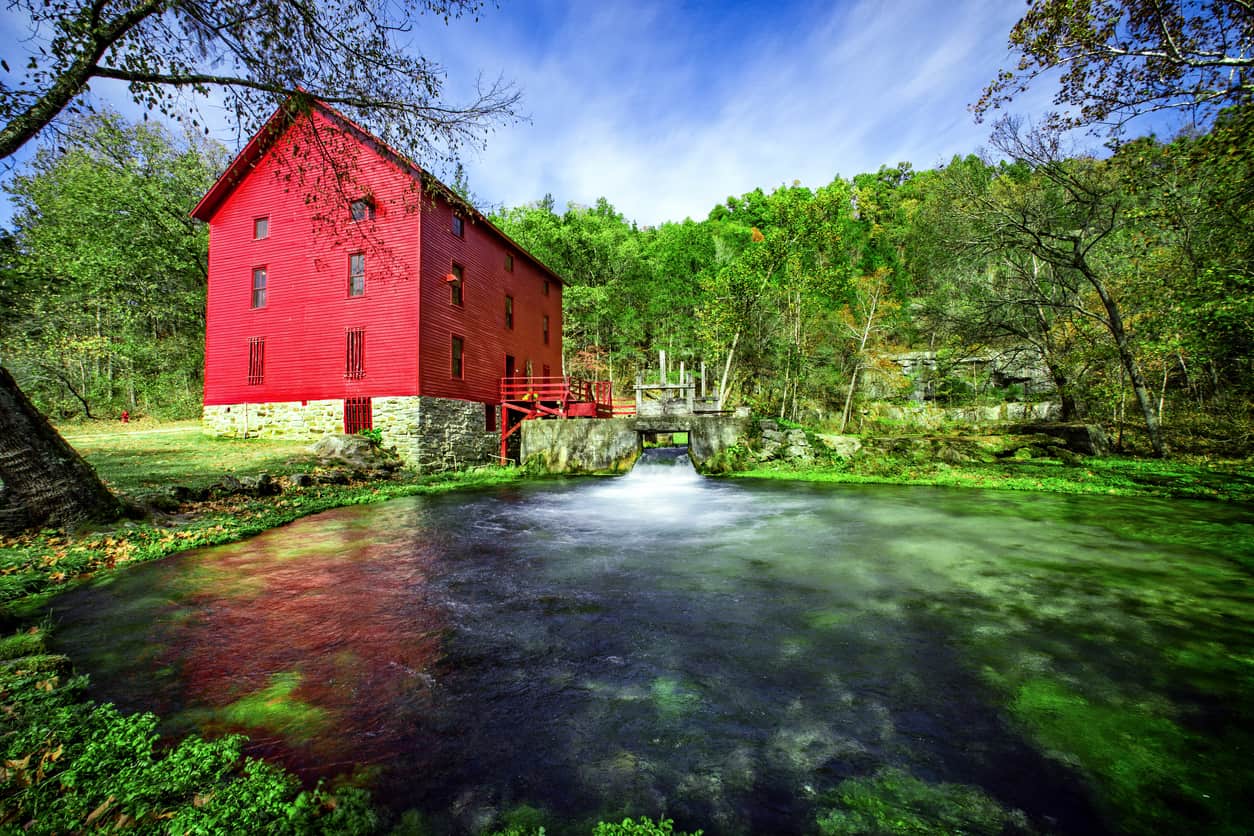
The Historic Alley Springs Mill in the Ozark National Scenic Riverways dates back to the late 19th century.
©iStock.com/StevenSchremp
2. Big Spring
As its name suggests, Big Spring is the largest spring in the state of Missouri. It was also one of Missouri’s first state parks. According to the National Park Service, it produces an average daily flow of 286 million gallons of water.
Big Spring is an enormous first-magnitude spring where underground passages carry water from miles away to emerge at its surface. The spring is also shown to be carrying large amounts of dissolved limestone.
Big Spring lies within Carter County in southern Missouri, off Highway 103. It is a part of the Ozark National Scenic Riverways and signs should direct visitors to the parking lot and trailhead.
The spring can be seen from the parking lot and is wheelchair-accessible via a walkway. Please note that swimming in Big Spring is prohibited.
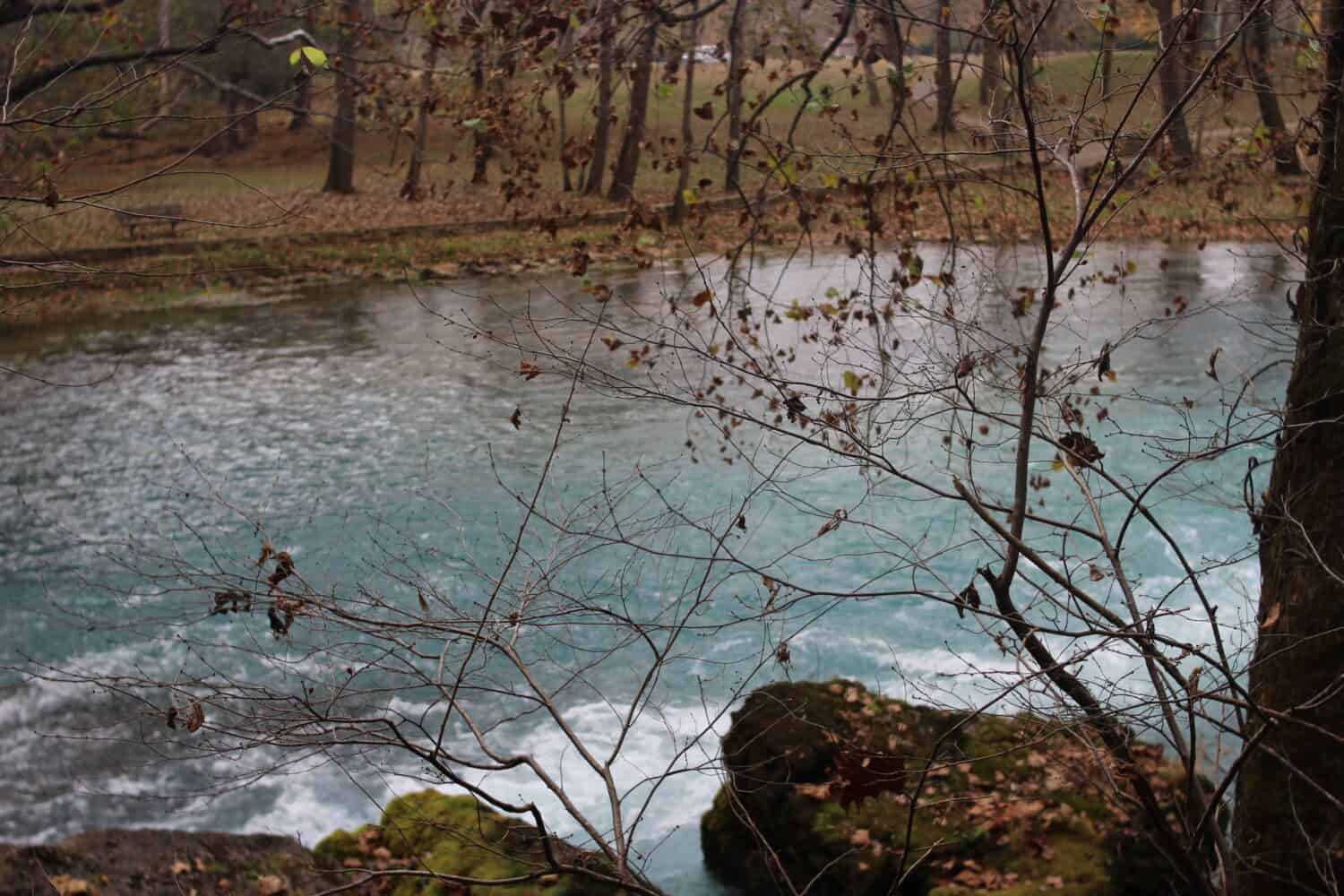
Big Spring is the largest natural spring in the state of Missouri.
©Ian Peter Morton/Shutterstock.com
3. Blue Spring
Several natural springs in Missouri share the same name as Blue Spring, but the one in Shannon County is by far the most impressive. According to the National Park Service, this spring is one of the deepest in the United States at over 310 feet deep.
Blue Spring is located on the Current River. Its incredible depth gives the spring a vivid, beautiful blue color. To preserve the spring and its stunning nature, swimming and wading in its waters are prohibited. The spring is so deep that you could completely submerge the Statue of Liberty in its waters!
Blue Spring is located in Shannon County, MO in the southern portion of the state. The spring is owned by the Missouri Department of Conservation and is surrounded by National Park Land.
Access the spring via a long dirt road off of State Route 106. National Park Services warns RVs and buses not to attempt traveling along the steep road, though regular vehicles should typically not have any problems.
From the parking lot, it’s about a 1/4 mile walk to the spring on a short trail where spring wildflowers abound. The spring is also about a 1/2 mile walk from the Powder Mill Campground.
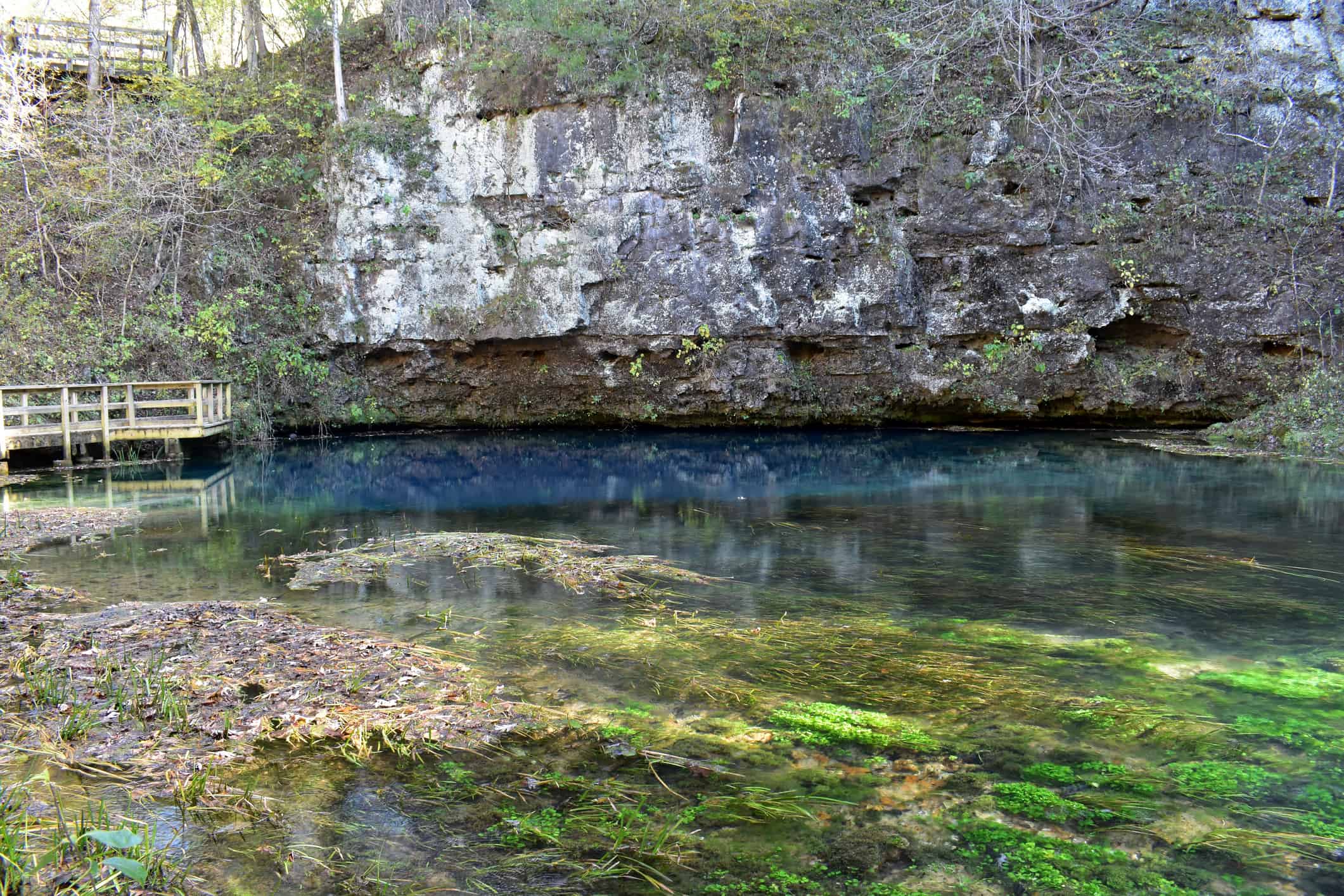
Blue Spring is the deepest spring in Missouri, at over 300 feet deep. The water is a vivid, deep blue color.
©Sandra Sapp/iStock via Getty Images
4. Hodgson Water Mill and Spring
Hodgson Water Mill and Spring combines history and nature. In 1861 William Holeman built a mill on Bryant Creek, according to the Ozark County Chamber of Commerce. It was later bought by Alva Hodgson. The original mill burnt down, so Hodgson built a new one in 1894 that remains to this day. The mill’s ownership eventually passed to Hodgson’s brother George and later to a man named Charles T. Aid.
Hodgson Mill stayed in production until 1977. The mill sits over a spring that reportedly produces 28,900,000 gallons of water a day. The spring once powered generators so that the owners of Hodgson Mill could run a cotton gin, sawmill, and overall factory. Bryant Creek experienced major flooding in the 1980s, and restorations on the Hodgson Mill property are still underway.
Hodgson Water Mill and Spring is located in Dora, MO in Ozark County. Visitors can reach the mill and the adjacent Sycamore Access via Highway 181. The Sycamore Access is a great spot for swimming, fishing, and launching canoes and kayaks to float down Bryant Creek. Sycamore Access is adjacent to Hodgson Water Mill.
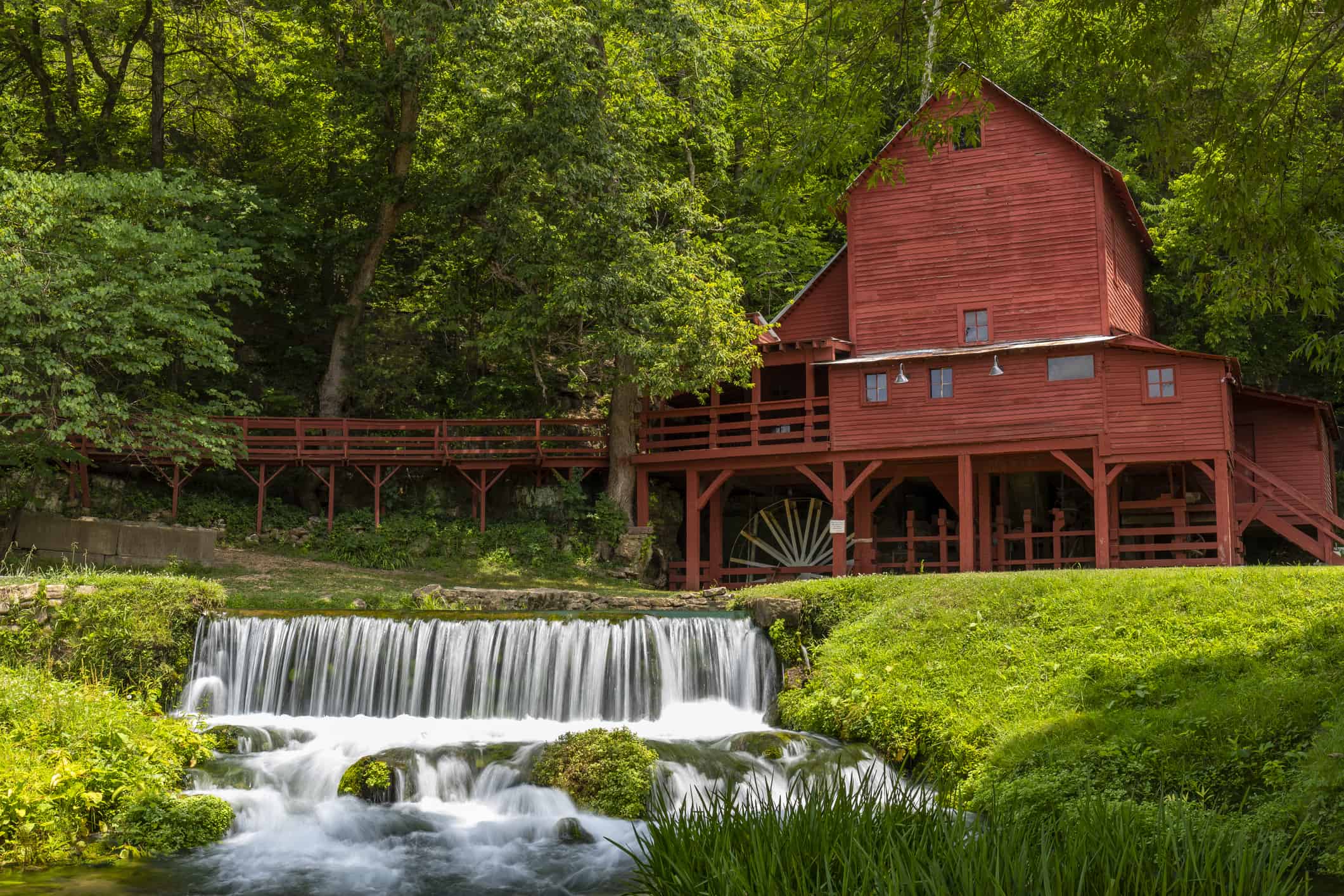
Hodgson Mill is an old red grist mill that sits above a natural spring.
©John_Brueske/iStock via Getty Images
5. Ha Ha Tonka Spring
Ha Ha Tonka State Park encompasses over 3,700 acres of natural wonders, historical ruins, and scenic bodies of water. Enjoy hiking, scenic walks, and birdwatching, or visit the ruins of a historic castle. The state park is also home to Ha Ha Tonka Spring.
According to Coleman Concierge, this spring is the 12th largest in the state and discharges more than 48 million gallons of water. The crystal clear water flows into the Trout Glenn Pool, which eventually empties into the Lake of the Ozarks.
Ha Ha Tonka State Park is located in Camden County in central Missouri. You can access the state park via Missouri D which leads to Natural Spring Road. As its name suggests, the Spring Trail takes visitors to Ha Ha Tonka Spring.
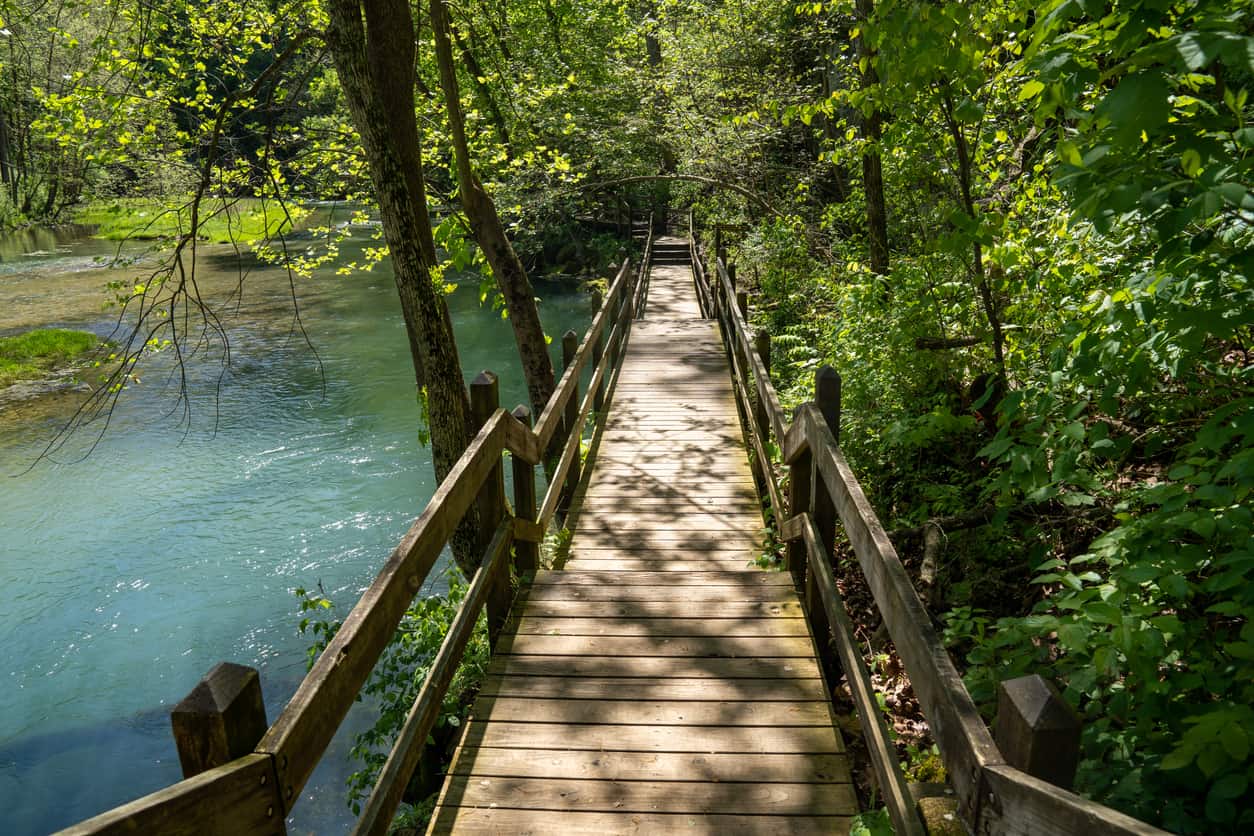
A pedestrian walking bridge gives visitors a beautiful view of Ha Ha Tonka Spring.
©iStock.com/Melissa Kopka
The first .40 mile of the trail is paved. It takes hikers along the shoreline of the Lake of the Ozarks and Ha Ha Tonka Spring, according to Missouri State Parks. After the second raceway, the trail surface becomes a wooden boardwalk. Hikers will need to squeeze between rocks as they near the spring, which emerges from a water-filled cave.
The hike from the trailhead to the mouth of the spring is only about a half mile. Visitors can turn back or continue on the Spring Trail, which becomes more strenuous.
The next section ascends 200 verticle feet up 316 wooden steps. After this hikers can turn right to continue on the Spring Trail, where they will shortly reach a stunning view of the spring waters and spot the castle ruins in the distance.
6. Greer Spring
Greer Spring is the second largest natural spring in Missouri. It has a mean daily discharge of approximately 210 million gallons/day, according to the Missouri Department of Conservation.
The spring flows for over a mile before emptying into Eleven Point River. Greer’s Springs waters come from nearby streams that flow underground, as well as sinkholes.
Greer Spring supports a diverse number of aquatic invertebrates, including some that are species of conservation concern. One of these creatures is the aptly named coldwater crayfish (Faxonius eupunctus), which thrives in water temperatures of around 58°F.
Greer Spring lies within Mark Twain National Forest in Oregon County, MO. The Greer Spring Trailhead lies off MO-19 and one of the closest towns is Alton. The trailhead should be easy to find once you pull into the parking lot.
From there it’s a .9 mile hike to Greer Spring. The trail leads hikers past a variety of trees such as oak, shortleaf pine, hickory, flowering dogwoods, and sassafras, according to the USDA Forest Service.
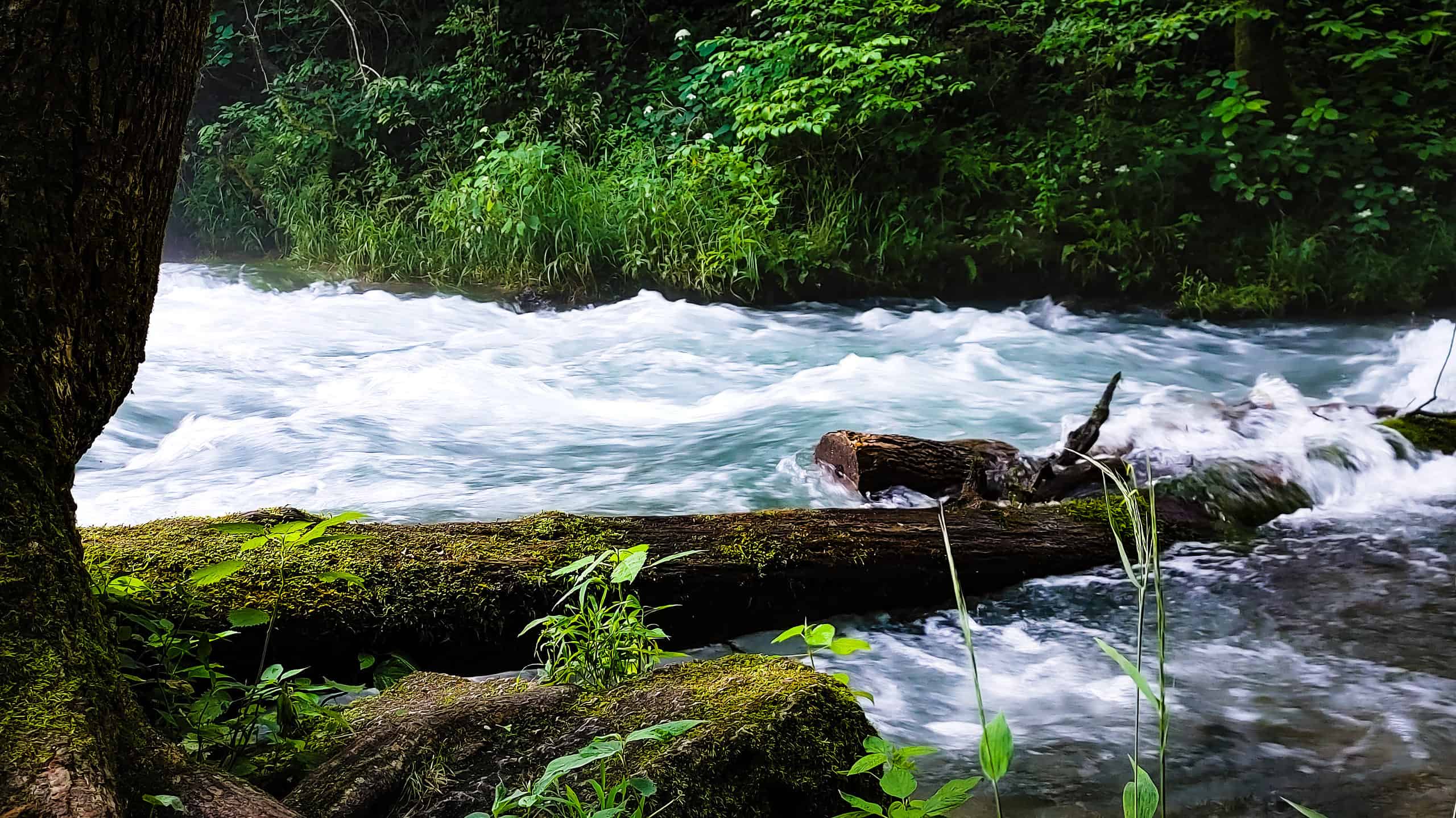
Discover the beauty of the second-largest spring in the state of Missouri.
©Heather Isquith/Shutterstock.com
7. Falling Spring
Falling Spring is another natural spring located in Missouri’s Mark Twain National Forest. According to the USDA Forest Service, this spring gets its name from the small waterfall that forms from spring waters pouring from a rock into a small pond.
Falling Spring once powered two mills, one of which remains standing to this day. Falling Spring Mill was built using timber between 1927 and 1929 and later enclosed with sawboard siding. It was used for a number of important tasks, such as grinding corn for feed, sawing out shingles and firewood, and generating electricity on the site.
Today you can visit the remains of Falling Spring Mill. Tomas Brown Cabin, the first of four houses built near the spring, remains intact as well. A rustic picnic area also lies beside the spring.
Like Greer Spring, Falling Spring lies within Mark Twain National Forest in Oregon County. Falling Spring is located off County Road 3164. After traveling a couple of miles on a gravel road you will pass the Falling Spring Cemetary and come across the parking lot for Falling Spring Mill.
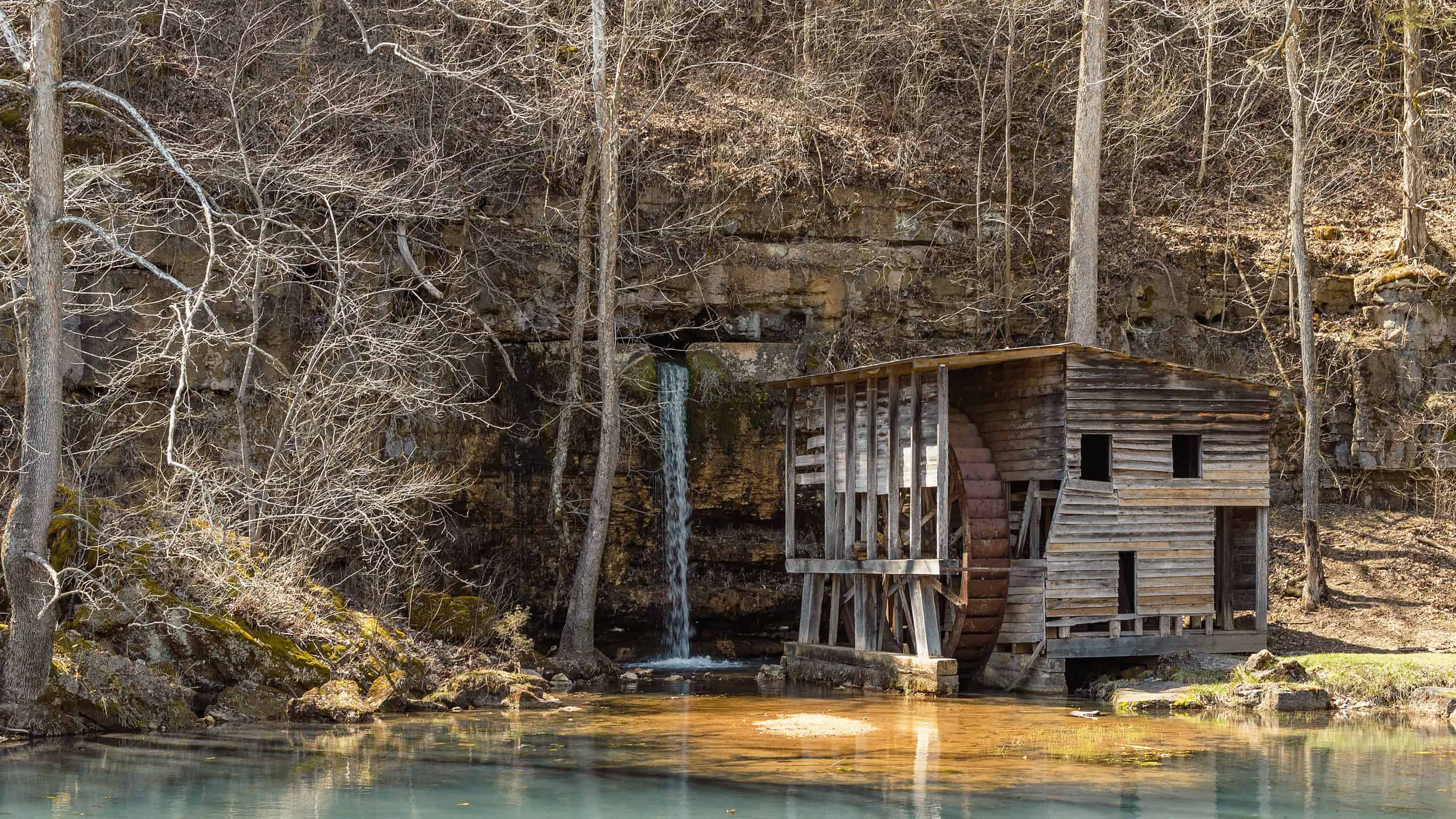
By the 1920s, the lumber mills that had once thrived in southern Missouri had vanished, and the result was widespread depletion of the region’s hickory, pine, and oak forests.
©Sally Jacobs/Shutterstock.com
8. Welch Spring
Welch Spring is yet another body of water on this list with a historical monument overlooking it. In 1913, an Illinois doctor named C.H. Diehl bought Welch Spring and built a hospital over the mouth of the cave from the spring flows, writes the National Park Service.
Diehl believed that the spring water contained healing properties and that the cave’s pollen-free air would help patients suffering from a number of diseases.
Though the hospital wasn’t a success during Diehl’s lifetime, in time tourists came to appreciate the area’s scenic beauty. Welch Spring is the eighth largest spring in the state of Missouri and emits 78.2 million gallons of water per day. The remains of the old hospital can be seen to this day.
Welch Spring is part of the Ozark National Scenic Riverways in Shannon County. The trail to reach Welch Spring lies off Highway K north of Atkers and is only 0.8 miles round trip. An easy walk from the trailhead parking lot takes visitors to the spring.
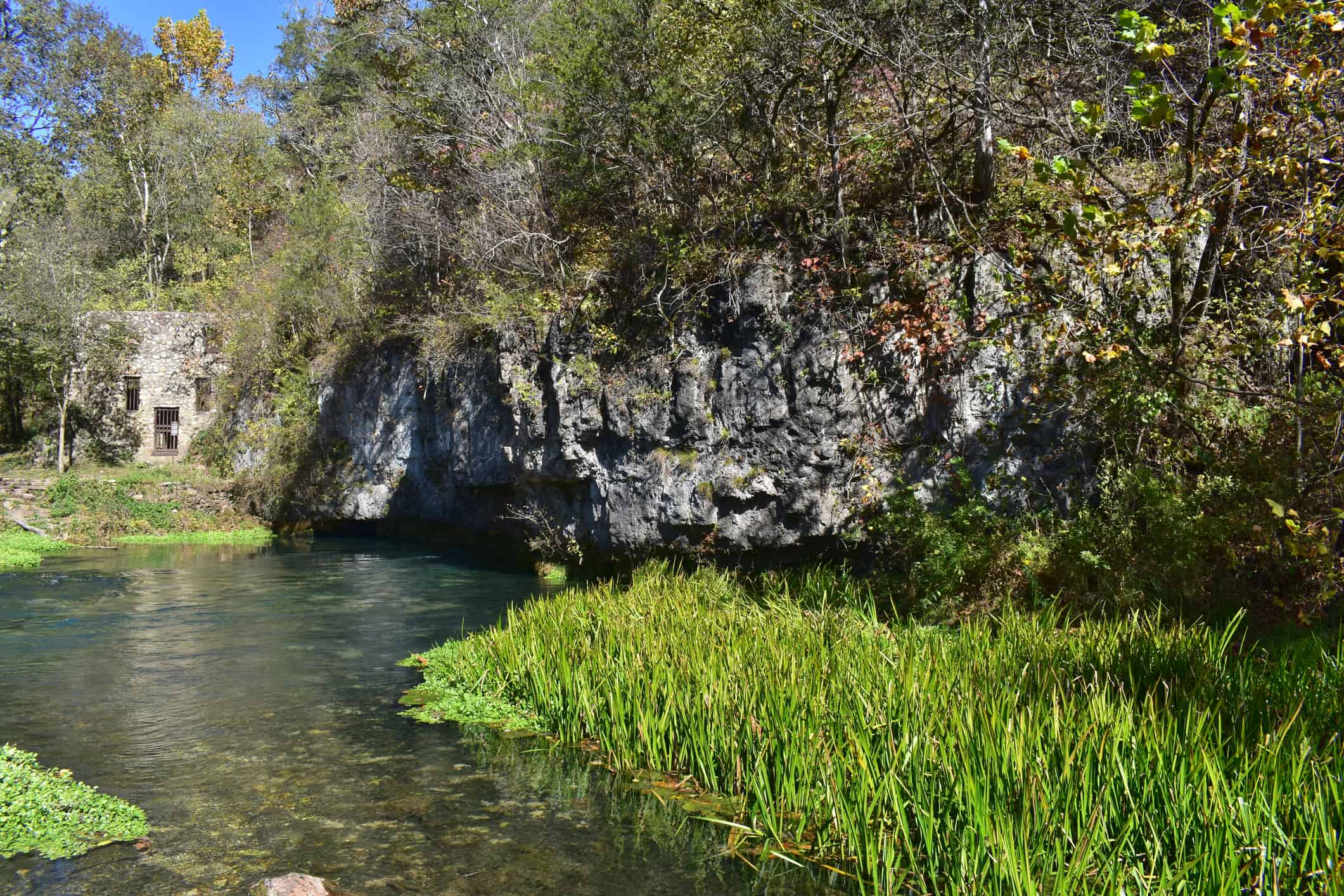
Welch Spring, near Jadwin, MO, is the site of both a beautiful spring and the old ruins of a hospital, or health spa, built in the early 1900s.
©Sandra Sapp/iStock via Getty Images
Summary of 8 Natural Springs in Missouri
| Number | Spring | Location |
|---|---|---|
| 1 | Alley Spring | Shannon County |
| 2 | Big Spring | Carter County |
| 3 | Blue Spring | Shannon County |
| 4 | Hodgson Water Mill and Spring | Ozark County |
| 5 | Ha Ha Tonka Spring | Camden County |
| 6 | Greer Spring | Oregon County |
| 7 | Falling Spring | Oregon County |
| 8 | Welch Spring | Shannon County |
Thank you for reading! Have some feedback for us? Contact the AZ Animals editorial team.

